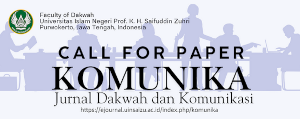ANALISIS WACANA KRITIS DALAM PERSPEKTIF NORMAN FAIRCLOUGH
DOI:
https://doi.org/10.24090/komunika.v8i1.746Keywords:
discourse, intertext, ideologyAbstract
Discourse analysis has been a study that attracts many intelectuals of various disciplines to discuss about, generating the emergence of theories of their own perspectives. Many criticisms for the theories also show that intelectuals are more interested in this field leading to make discourse analysis as a multidisciplinary study. Based on this ground, Norman Fairclough seeks to reconstruct discourse theory as a criticism to the existing theories, which tends to be side-emphasis and partial on the basis of their own discipline. Combining three traditions, i.e. linguistic, interpretative, and sociological traditions, he offers a discourse model integrating three dimensions: text, discourse practice, and social practice. Each dimension has its area, process, and analysis model, in which all of them dialectically connect to one another. In addition, Fairclough also formulates another important concept, namely intertextuality, which affirms the interrelation of various texts and discourses to a text. This concept will also create ideological effect of structuration and restructuration of the prevalent discourse order. When power and ideology embed in a discourse, intertextuality will function as a mechanism for maintaining and changing the domination relation.Downloads
Download data is not yet available.
References
Althusser, Louis. 1993. Essays on Ideology. London & New York: Verso.
Bakhtin, M.M. 1986. Speech Genres and Other Late Essays. Austin: University of Texas Press.
Butler, Judith. 1999. Gender Trouble: Feminism and the Subversion of Identity. London and New York: Routledge.
————. 2004. Undoing Gender. New York & London: Routledge. Fairclough, Norman. 1992. Discourse and Social Change. Cambridge: Polity Press.
————.1995. Critical Discourse Analysis: the Critical Study of Language. London dan New York: Longman.
————. 2001. Language and Power. England: Pearson Educated Limited.
Hall, Stuart. 1997. “Introductionâ€, in Stuart Hall (ed.). Representation: Cultural Representations and Signifying Practices. London: The Open University.
Hardiman, F. Budi. 2009. Menuju Masyarakat Komunikatif. Yogyakarta: Kanisius.
Jorgensen, Marianne and Phillips, Louise. 2002. Discourse Analysis as Theory and Method. Los Angeles: Sage.
Littlejohn, Stephen W. 1992. Theories of Human Communication. California: Wads-worth Publishing Company.
Mills, Sara. 2001. Discourse. New York & London: Routledge.
Piliang, Yasraf Amir. 2004. Dunia yang Dilipat. Yogyakarta: Jalasutra.
Said, Edward W. 1983. The World, the Text and the Critic. Cambridge, Massachussets: Harvard University Press.
Thwaites, Tony and Mules, Warwick. 2002. Introducing Cultural and Media Stu dies. Australia: Palgrave.
Weedon, Chris. 1998. Feminist Practice and Theory. Monash: Monash University Press.
Bakhtin, M.M. 1986. Speech Genres and Other Late Essays. Austin: University of Texas Press.
Butler, Judith. 1999. Gender Trouble: Feminism and the Subversion of Identity. London and New York: Routledge.
————. 2004. Undoing Gender. New York & London: Routledge. Fairclough, Norman. 1992. Discourse and Social Change. Cambridge: Polity Press.
————.1995. Critical Discourse Analysis: the Critical Study of Language. London dan New York: Longman.
————. 2001. Language and Power. England: Pearson Educated Limited.
Hall, Stuart. 1997. “Introductionâ€, in Stuart Hall (ed.). Representation: Cultural Representations and Signifying Practices. London: The Open University.
Hardiman, F. Budi. 2009. Menuju Masyarakat Komunikatif. Yogyakarta: Kanisius.
Jorgensen, Marianne and Phillips, Louise. 2002. Discourse Analysis as Theory and Method. Los Angeles: Sage.
Littlejohn, Stephen W. 1992. Theories of Human Communication. California: Wads-worth Publishing Company.
Mills, Sara. 2001. Discourse. New York & London: Routledge.
Piliang, Yasraf Amir. 2004. Dunia yang Dilipat. Yogyakarta: Jalasutra.
Said, Edward W. 1983. The World, the Text and the Critic. Cambridge, Massachussets: Harvard University Press.
Thwaites, Tony and Mules, Warwick. 2002. Introducing Cultural and Media Stu dies. Australia: Palgrave.
Weedon, Chris. 1998. Feminist Practice and Theory. Monash: Monash University Press.
Downloads
Issue
Section
Articles
License
Authors who publish with this journal agree to the following terms:
- Authors retain copyright and grant the journal right of first publication with the work simultaneously licensed under a Creative Commons Attribution-ShareAlike 4.0 International License that allows others to share the work with an acknowledgement of the work's authorship and initial publication in this journal.
- Authors are able to enter into separate, additional contractual arrangements for the non-exclusive distribution of the journal's published version of the work (e.g., post it to an institutional repository or publish it in a book), with an acknowledgement of its initial publication in this journal.
- Authors are permitted and encouraged to post their work online (e.g., in institutional repositories or on their website) prior to and during the submission process, as it can lead to productive exchanges, as well as earlier and greater citation of published work (See The Effect of Open Access).

























